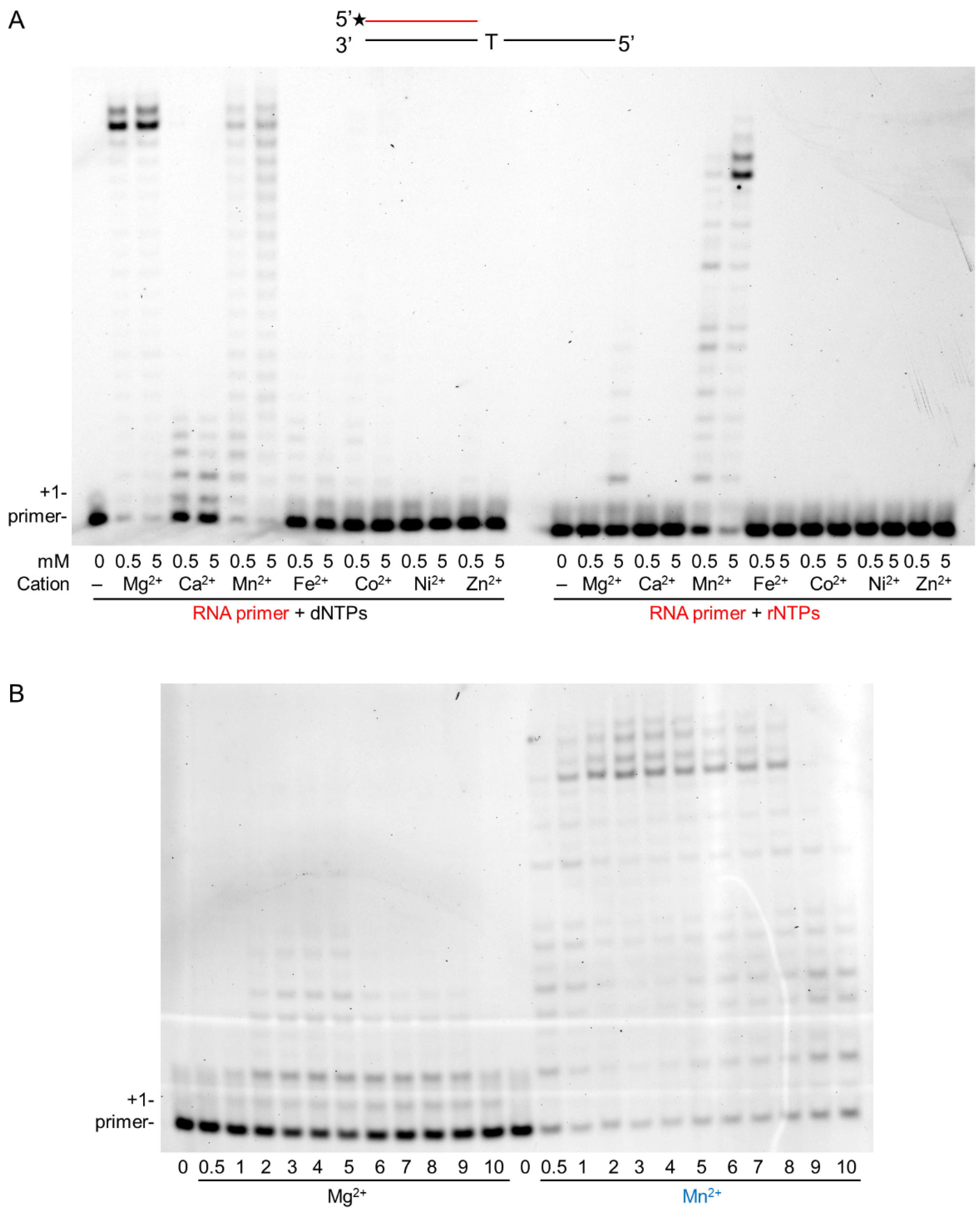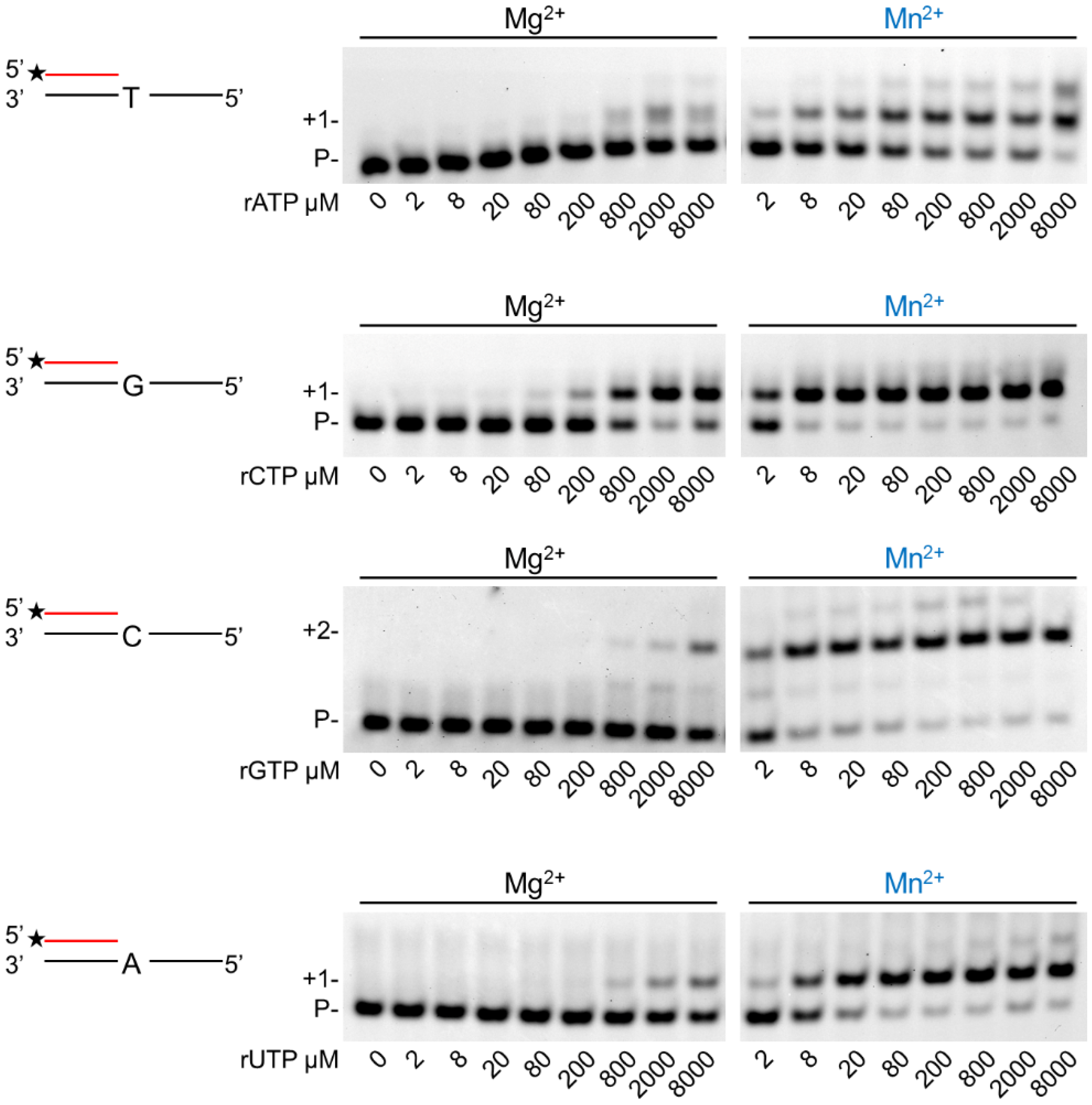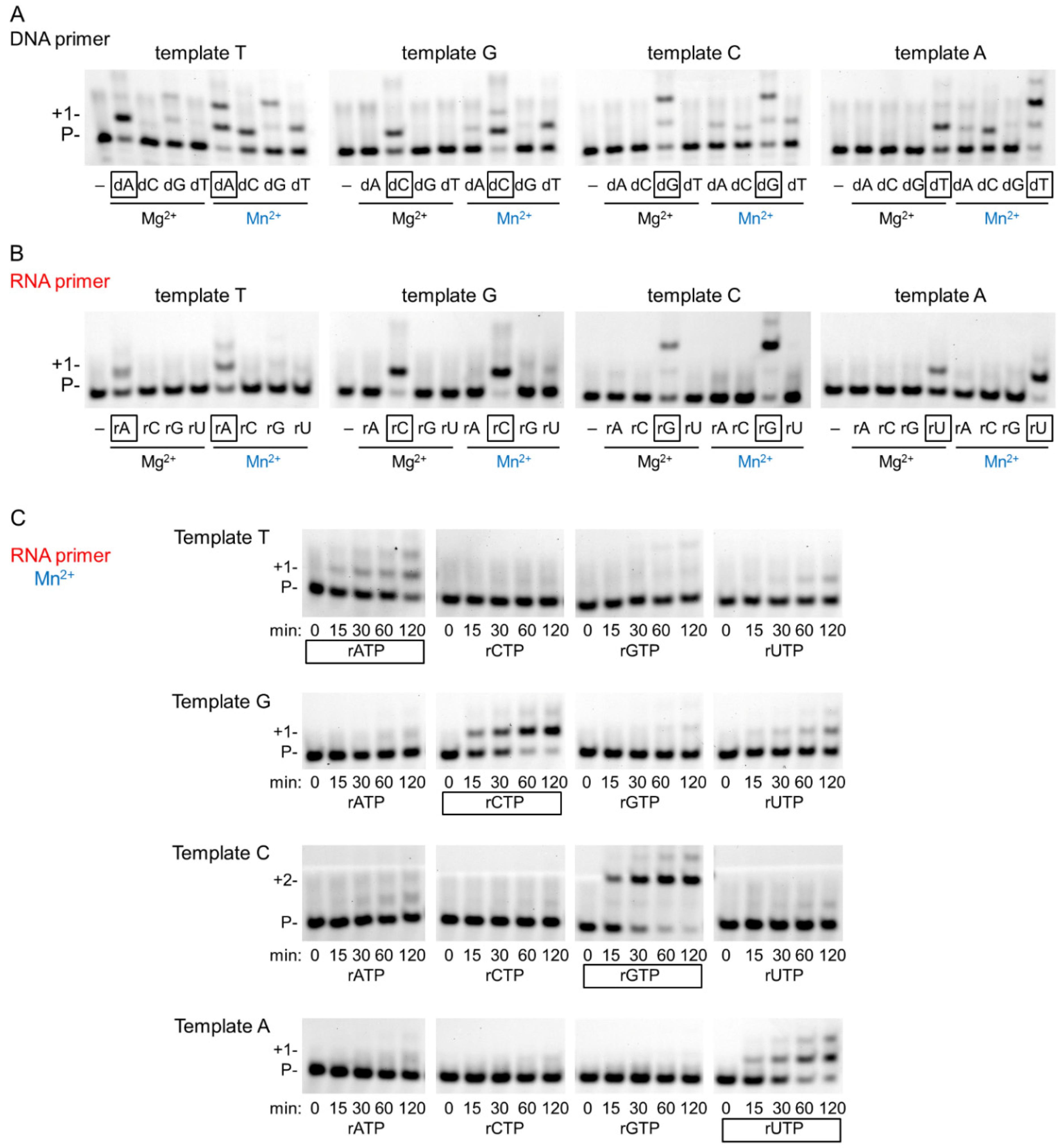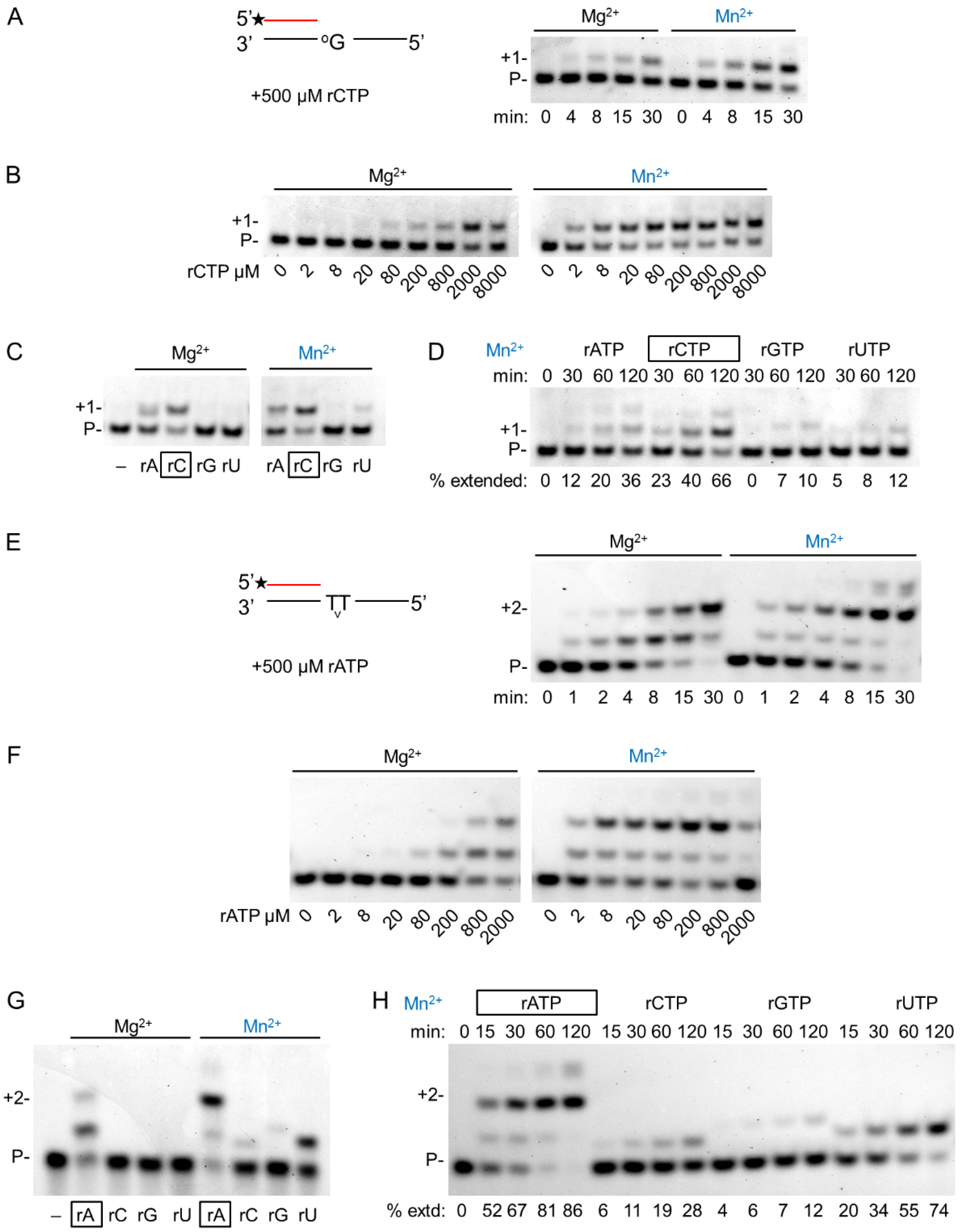Manganese Is a Strong Specific Activator of the RNA Synthetic Activity of Human Polη
Abstract
:1. Introduction
2. Results
2.1. Metal Cation Dependency of the RNA Extension by hPolη
2.2. Manganese Is a Specific Activator of hPolη during RNA Extension
2.3. Fidelity of RNA Extension Using Manganese
2.4. DNA Damage Bypass during RNA Synthesis in the Presence of Manganese
3. Discussion
4. Materials and Methods
4.1. Protein Purification
4.2. Oligonucleotides
4.3. Electrophoretic Mobility Shift Assays
4.4. Primer Extension Assays
4.5. Determination of Steady-State Kinetic Parameters
Author Contributions
Funding
Acknowledgments
Conflicts of Interest
References
- Prakash, S.; Johnson, R.E.; Prakash, L. EUKARYOTIC TRANSLESION SYNTHESIS DNA POLYMERASES: Specificity of Structure and Function. Annu. Rev. Biochem. 2005, 74, 317–353. [Google Scholar] [CrossRef]
- Vaisman, A.; Woodgate, R. Translesion DNA polymerases in eukaryotes: What makes them tick? Crit. Rev. Biochem. Mol. Biol. 2017, 52, 274–303. [Google Scholar] [CrossRef] [Green Version]
- Dumstorf, C.A.; Mukhopadhyay, S.; Krishnan, E.; Haribabu, B.; McGregor, W.G. REV1 Is Implicated in the Development of Carcinogen-Induced Lung Cancer. Mol. Cancer Res. 2009, 7, 247–254. [Google Scholar] [CrossRef] [PubMed] [Green Version]
- Pan, Q.; Wang, L.; Liu, Y.; Li, M.; Zhang, Y.; Peng, W.; Deng, T.; Peng, M.-L.; Jiang, J.-Q.; Tang, J.; et al. Knockdown of POLQ interferes the development and progression of hepatocellular carcinoma through regulating cell proliferation, apoptosis and migration. Cancer Cell Int. 2021, 21, 482. [Google Scholar] [CrossRef] [PubMed]
- Ohkumo, T.; Kondo, Y.; Yokoi, M.; Tsukamoto, T.; Yamada, A.; Sugimoto, T.; Kanao, R.; Higashi, Y.; Kondoh, H.; Tatematsu, M.; et al. UV-B Radiation Induces Epithelial Tumors in Mice Lacking DNA Polymerase η and Mesenchymal Tumors in Mice Deficient for DNA Polymerase ι. Mol. Cell. Biol. 2006, 26, 7696–7706. [Google Scholar] [CrossRef] [PubMed] [Green Version]
- Lee, G.-H.; Matsushita, H. Genetic linkage between Politoa deficiency and increased susceptibility to lung tumors in mice. Cancer Sci. 2005, 96, 256–259. [Google Scholar] [CrossRef]
- Lin, Q.; Clark, A.B.; McCulloch, S.D.; Yuan, T.; Bronson, R.T.; Kunkel, T.A.; Kucherlapati, R. Increased Susceptibility to UV-Induced Skin Carcinogenesis in Polymerase η–deficient Mice. Cancer Res. 2006, 66, 87–94. [Google Scholar] [CrossRef] [PubMed] [Green Version]
- Yoon, J.-H.; McArthur, M.J.; Park, J.; Basu, D.; Wakamiya, M.; Prakash, L.; Prakash, S. Error-Prone Replication through UV Lesions by DNA Polymerase θ Protects against Skin Cancers. Cell 2019, 176, 1295–1309.e15. [Google Scholar] [CrossRef] [Green Version]
- Johnson, R.E.; Kondratick, C.M.; Prakash, S.; Prakash, L. hRAD30 Mutations in the Variant Form of Xeroderma Pigmentosum. Science 1999, 285, 263–265. [Google Scholar] [CrossRef]
- Masutani, C.; Kusumoto, R.; Yamada, A.; Dohmae, N.; Yokoi, M.; Yuasa, M.; Araki, M.; Iwai, S.; Takio, K.; Hanaoka, F. The XPV (xeroderma pigmentosum variant) gene encodes human DNA polymerase η. Nature 1999, 399, 700–704. [Google Scholar] [CrossRef]
- Haracska, L.; Yu, S.-L.; Johnson, R.E.; Prakash, L.; Prakash, S. Efficient and accurate replication in the presence of 7,8-dihydro-8-oxoguanine by DNA polymerase η. Nat. Genet. 2000, 25, 458–461. [Google Scholar] [CrossRef]
- Haracska, L.; Prakash, S.; Prakash, L. Replication past O 6 -Methylguanine by Yeast and Human DNA Polymerase η. Mol. Cell. Biol. 2000, 20, 8001–8007. [Google Scholar] [CrossRef]
- Haracska, L.; Washington, T.; Prakash, S.; Prakash, L. Inefficient Bypass of an Abasic Site by DNA Polymerase η. J. Biol. Chem. 2001, 276, 6861–6866. [Google Scholar] [CrossRef] [Green Version]
- Patra, A.; Zhang, Q.; Lei, L.; Su, Y.; Egli, M.; Guengerich, F.P. Structural and Kinetic Analysis of Nucleoside Triphosphate Incorporation Opposite an Abasic Site by Human Translesion DNA Polymerase η. J. Biol. Chem. 2015, 290, 8028–8038. [Google Scholar] [CrossRef] [PubMed] [Green Version]
- Vaisman, A.; Masutani, C.; Hanaoka, F.; Chaney, S.G. Efficient Translesion Replication Past Oxaliplatin and Cisplatin GpG Adducts by Human DNA Polymerase η. Biochemistry 2000, 39, 4575–4580. [Google Scholar] [CrossRef] [PubMed]
- Albertella, M.R.; Green, C.; Lehmann, A.R.; O’Connor, M.J. A Role for Polymerase η in the Cellular Tolerance to Cisplatin-Induced Damage. Cancer Res. 2005, 65, 9799–9806. [Google Scholar] [CrossRef] [Green Version]
- McElhinny, S.A.N.; Watts, B.E.; Kumar, D.; Watt, D.L.; Lundström, E.-B.; Burgers, P.M.J.; Johansson, E.; Chabes, A.; Kunkel, T.A. Abundant ribonucleotide incorporation into DNA by yeast replicative polymerases. Proc. Natl. Acad. Sci. USA 2010, 107, 4949–4954. [Google Scholar] [CrossRef] [Green Version]
- Su, Y.; Egli, M.; Guengerich, F.P. Mechanism of Ribonucleotide Incorporation by Human DNA Polymerase η. J. Biol. Chem. 2016, 291, 3747–3756. [Google Scholar] [CrossRef] [Green Version]
- Vaisman, A.; Woodgate, R. Ribonucleotide discrimination by translesion synthesis DNA polymerases. Crit. Rev. Biochem. Mol. Biol. 2018, 53, 382–402. [Google Scholar] [CrossRef]
- Mentegari, E.; Crespan, E.; Bavagnoli, L.; Kissova, M.; Bertoletti, F.; Sabbioneda, S.; Imhof, R.; Sturla, S.J.; Nilforoushan, A.; Hübscher, U.; et al. Ribonucleotide incorporation by human DNA polymerase η impacts translesion synthesis and RNase H2 activity. Nucleic Acids Res. 2016, 45, 2600–2614. [Google Scholar] [CrossRef] [PubMed] [Green Version]
- Eder, P.; Walder, R.; Walder, J.A. Substrate specificity of human RNase H1 and its role in excision repair of ribose residues misincorporated in DNA. Biochimie 1993, 75, 123–126. [Google Scholar] [CrossRef]
- Rydberg, B.; Game, J. Excision of misincorporated ribonucleotides in DNA by RNase H (type 2) and FEN-1 in cell-free extracts. Proc. Natl. Acad. Sci. USA 2002, 99, 16654–16659. [Google Scholar] [CrossRef] [Green Version]
- Sparks, J.L.; Chon, H.; Cerritelli, S.M.; Kunkel, T.A.; Johansson, E.; Crouch, R.J.; Burgers, P.M. RNase H2-Initiated Ribonucleotide Excision Repair. Mol. Cell 2012, 47, 980–986. [Google Scholar] [CrossRef] [Green Version]
- Crow, Y.J.; Leitch, A.; Hayward, B.E.; Garner, A.; Parmar, R.; Griffith, E.; Ali, M.; Semple, C.; Aicardi, J.; Babul-Hirji, R.; et al. Mutations in genes encoding ribonuclease H2 subunits cause Aicardi-Goutières syndrome and mimic congenital viral brain infection. Nat. Genet. 2006, 38, 910–916. [Google Scholar] [CrossRef]
- Günther, C.; Kind, B.; Reijns, M.; Berndt, N.; Bueno, M.M.; Wolf, C.; Tüngler, V.; Chara, O.; Lee, Y.A.; Hübner, N.; et al. Defective removal of ribonucleotides from DNA promotes systemic autoimmunity. J. Clin. Investig. 2014, 125, 413–424. [Google Scholar] [CrossRef]
- Su, Y.; Egli, M.; Guengerich, F.P. Human DNA polymerase η accommodates RNA for strand extension. J. Biol. Chem. 2017, 292, 18044–18051. [Google Scholar] [CrossRef] [Green Version]
- Su, Y.; Ghodke, P.P.; Egli, M.; Li, L.; Wang, Y.; Guengerich, F.P. Human DNA polymerase η has reverse transcriptase activity in cellular environments. J. Biol. Chem. 2019, 294, 6073–6081. [Google Scholar] [CrossRef] [Green Version]
- Gali, V.K.; Balint, E.; Serbyn, N.; Frittmann, O.; Stutz, F.; Unk, I. Translesion synthesis DNA polymerase η exhibits a specific RNA extension activity and a transcription-associated function. Sci. Rep. 2017, 7, 13055. [Google Scholar] [CrossRef] [Green Version]
- Balint, E.; Unk, I. Selective Metal Ion Utilization Contributes to the Transformation of the Activity of Yeast Polymerase η from DNA Polymerization toward RNA Polymerization. Int. J. Mol. Sci. 2020, 21, 8248. [Google Scholar] [CrossRef]
- Pelletier, H.; Sawaya, M.R.; Wolfle, W.; Wilson, S.H.; Kraut, J. A Structural Basis for Metal Ion Mutagenicity and Nucleotide Selectivity in Human DNA Polymerase β. Biochemistry 1996, 35, 12762–12777. [Google Scholar] [CrossRef]
- Blanca, G.; Shevelev, I.; Ramadan, K.; Villani, G.; Spadari, S.; Hübscher, U.; Maga, G. Human DNA Polymerase λ Diverged in Evolution from DNA Polymerase β toward Specific Mn++ Dependence: A Kinetic and Thermodynamic Study. Biochemistry 2003, 42, 7467–7476. [Google Scholar] [CrossRef]
- Martin, M.J.; Garcia-Ortiz, M.V.; Esteban, V.; Blanco, L. Ribonucleotides and manganese ions improve non-homologous end joining by human Polµ. Nucleic Acids Res. 2012, 41, 2428–2436. [Google Scholar] [CrossRef] [Green Version]
- Frank, E.G.; Woodgate, R. Increased Catalytic Activity and Altered Fidelity of Human DNA Polymerase ι in the Presence of Manganese. J. Biol. Chem. 2007, 282, 24689–24696. [Google Scholar] [CrossRef] [Green Version]
- Zafar, M.K.; Ketkar, A.; Lodeiro, M.F.; Cameron, C.E.; Eoff, R.L. Kinetic Analysis of Human PrimPol DNA Polymerase Activity Reveals a Generally Error-Prone Enzyme Capable of Accurately Bypassing 7,8-Dihydro-8-oxo-2′-deoxyguanosine. Biochemistry 2014, 53, 6584–6594. [Google Scholar] [CrossRef] [Green Version]
- Tan, Y.; Guo, S.; Wu, J.; Du, H.; Li, L.; You, C.; Wang, Y. DNA Polymerase η Promotes the Transcriptional Bypass of N2-Alkyl-2′-deoxyguanosine Adducts in Human Cells. J. Am. Chem. Soc. 2021, 143, 16197–16205. [Google Scholar] [CrossRef]






| Templating Nucleotide | Incoming Nucleotide | Cation | kcat (min−1) | Km (µM) | kcat/Km (min−1µM−1) | Relative Efficiency a | 1/Relative Efficiency b |
|---|---|---|---|---|---|---|---|
| T | rATP | Mn2+ | 0.30 ± 0.01 | 5.9 ± 0.7 | 5.2 × 10−2 | - | 1 |
| rUTP | Mn2+ | 0.048 ± 0.002 | 634 ± 144 | 7.5 × 10−5 | - | 690 | |
| G | rCTP | Mg2+ | 0.86 ± 0.05 | 1427 ± 202 | 6.0 × 10−4 | 1 | - |
| rCTP | Mn2+ | 1.27 ± 0.04 | 4.9 ± 0.6 | 2.6 × 10−1 | 430 | 1 | |
| rUTP | Mn2+ | 0.064 ± 0.004 | 995 ± 226 | 6.5 × 10−5 | - | 3970 | |
| C | rGTP | Mg2+ | 0.34 ± 0.06 | 6260 ± 1564 | 5.5 × 10−5 | 1 | - |
| rGTP | Mn2+ | 0.54 ± 0.02 | 7.9 ± 0.9 | 6.9 × 10−2 | 1260 | 1 | |
| rUTP | Mn2+ | 0.030 ± 0.004 | 1274 ± 519 | 2.4 × 10−5 | - | 2950 | |
| A | rUTP | Mg2+ | 0.37 ± 0.04 | 4820 ± 860 | 7.6 × 10−5 | 1 | - |
| rUTP | Mn2+ | 0.89 ± 0.03 | 15 ± 2.0 | 5.9 × 10−2 | 780 | - | |
| TT dimer | rATP | Mg2+ | 0.54 ± 0.04 | 630 ± 124 | 8.3 × 10−4 | 1 | - |
| rATP | Mn2+ | 0.54 ± 0.02 | 3.6 ± 0.6 | 1.5 × 10−1 | 180 | - | |
| 8-oxoG | rCTP | Mg2+ | 0.11 ± 0.01 | 590 ± 123 | 1.8 × 10−4 | 1 | - |
| rCTP | Mn2+ | 0.18 ± 0.01 | 4.0 ± 0.5 | 4.6 × 10−2 | 260 | - |
Publisher’s Note: MDPI stays neutral with regard to jurisdictional claims in published maps and institutional affiliations. |
© 2021 by the authors. Licensee MDPI, Basel, Switzerland. This article is an open access article distributed under the terms and conditions of the Creative Commons Attribution (CC BY) license (https://creativecommons.org/licenses/by/4.0/).
Share and Cite
Balint, E.; Unk, I. Manganese Is a Strong Specific Activator of the RNA Synthetic Activity of Human Polη. Int. J. Mol. Sci. 2022, 23, 230. https://doi.org/10.3390/ijms23010230
Balint E, Unk I. Manganese Is a Strong Specific Activator of the RNA Synthetic Activity of Human Polη. International Journal of Molecular Sciences. 2022; 23(1):230. https://doi.org/10.3390/ijms23010230
Chicago/Turabian StyleBalint, Eva, and Ildiko Unk. 2022. "Manganese Is a Strong Specific Activator of the RNA Synthetic Activity of Human Polη" International Journal of Molecular Sciences 23, no. 1: 230. https://doi.org/10.3390/ijms23010230
APA StyleBalint, E., & Unk, I. (2022). Manganese Is a Strong Specific Activator of the RNA Synthetic Activity of Human Polη. International Journal of Molecular Sciences, 23(1), 230. https://doi.org/10.3390/ijms23010230







